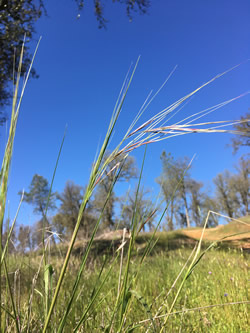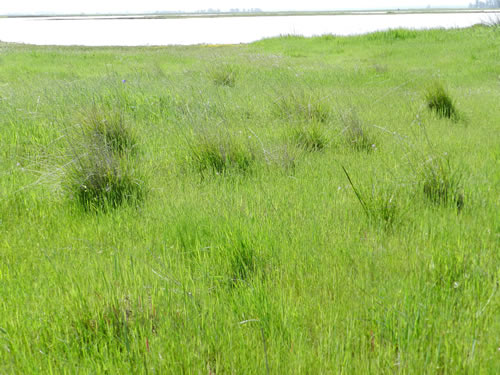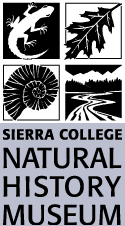Purple Needlegrass
Shawna Martinez
Botany Instructor, Sierra College
 Purple Needlegrass (Stipa pulchra) is a tufted perennial bunchgrass. It is a true grass of the enormous grass family and grows sparingly in the Great Valley, but more commonly in the foothills of California, predominantly within Blue Oak Savannas. Purple needlegrass became California’s state grass in 2004. It was selected due to its widespread nature, uses by Native Americans, and important ecological role it plays in various plant communities. We like to think that it was also chosen for its elegance and beauty.
Purple Needlegrass (Stipa pulchra) is a tufted perennial bunchgrass. It is a true grass of the enormous grass family and grows sparingly in the Great Valley, but more commonly in the foothills of California, predominantly within Blue Oak Savannas. Purple needlegrass became California’s state grass in 2004. It was selected due to its widespread nature, uses by Native Americans, and important ecological role it plays in various plant communities. We like to think that it was also chosen for its elegance and beauty.
Purple needlegrass is a moderately-sized, beautiful grass, standing 2-3 feet tall when it is flowering. This species is long-lived—up to 200 years—and is a perennial “bunchgrass”. It is so named due to the dense clusters of basal leaves that come up year after year from the soil held tightly together in a common cluster or bunch. The aggressive roots from this grass can extend down into the soil 16 feet, allowing the grass to extract moisture from the deep soils during the hot, dry summers. In addition, the deep root system of the grass allows for survival of oak seedlings by maintaining a deeper soil moisture (oak roots thrust downward deeply). This also promotes the growth of beneficial mycorrhizal fungi—which, in turn, help the oaks flourish by transferring absorbed minerals in symbiotic exchange for a little photosynthetic sugar.
Their Look Is Their Name
Wispy, long flowering stalks help to identify this grass—the tops of the seed heads are a delicate purple-golden color and have double bent “awns” or seed extensions—making each seed look like a needle and thread. This species is a prolific reproducer, producing up to 227 pounds of seed per acre.
At one time, it was thought that purple needlegrass dominated the interior valleys of California, much like the Tall Grass Prairies of the Midwest. It has been recently surmised that despite modern vegetation changes and inclusion of non-native annual grasses in the Great Valley, that purple needlegrass and other perennial bunchgrasses may have never flourished abundantly in this region. That said, bunchgrasses still inhabit an iconic range within the Oak Savannas that ring the valley. Here, within the Oak Savanna (open oak woodlands interspersed with grassland) Purple Needlegrass provided necessary forage for grazing and browsing animals such as mule deer, pronghorn antelope, and Tule Elk. Native Americans primarily harvested the seeds of the Purple Needlegrass, among other grasses for food.
This particular bunchgrass is very well suited for naturalizing in a xeric (dry) landscaping. It is a preferred choice for use in a dry meadow, or as accents in rock gardens, and mixed borders. It has also been used successfully for restoration projects, particularly after removing competing, non-native vegetation such as yellow star thistle and numerous other introduced plants.

Photo Credits
- Joe Medeiros
